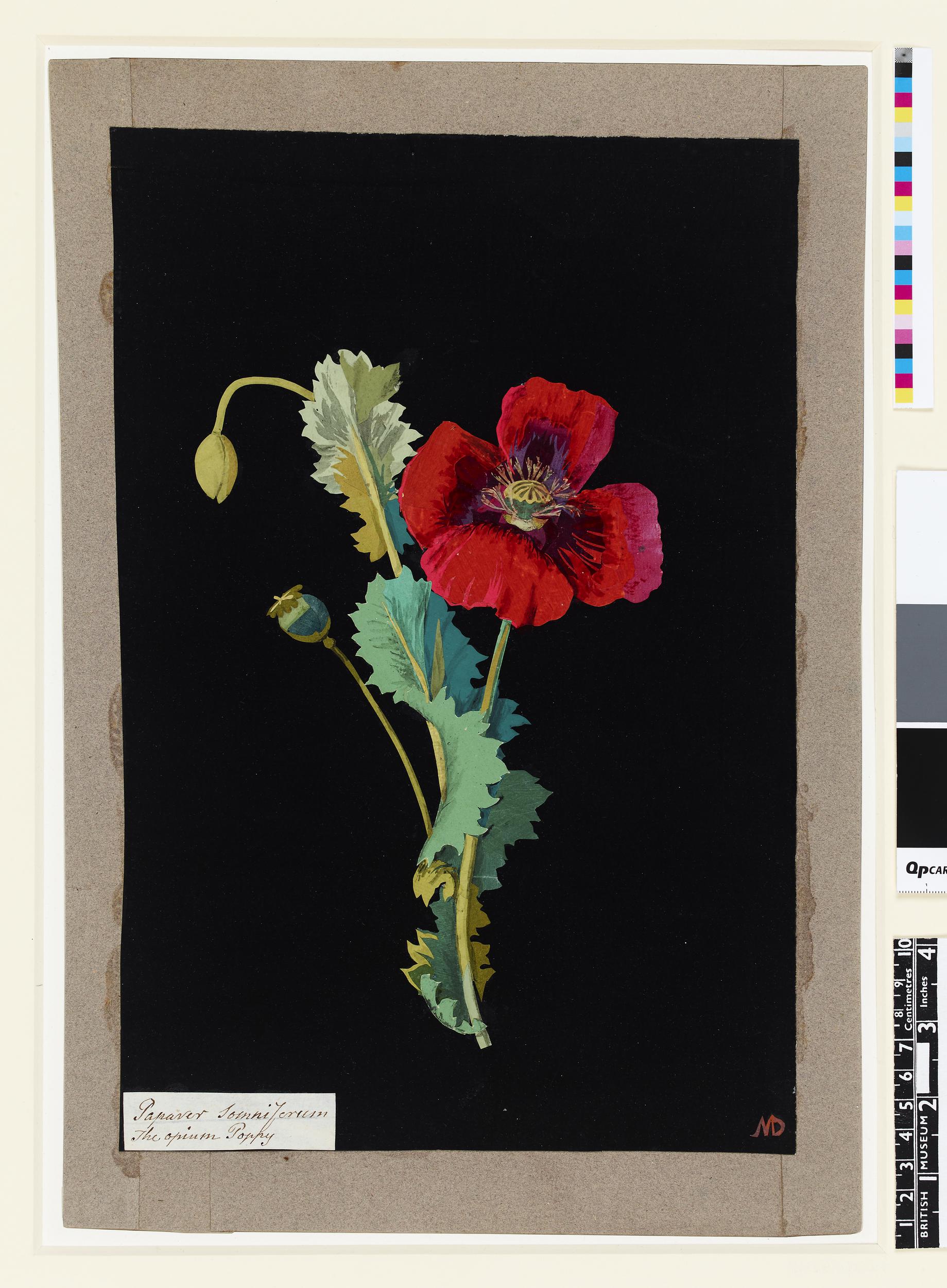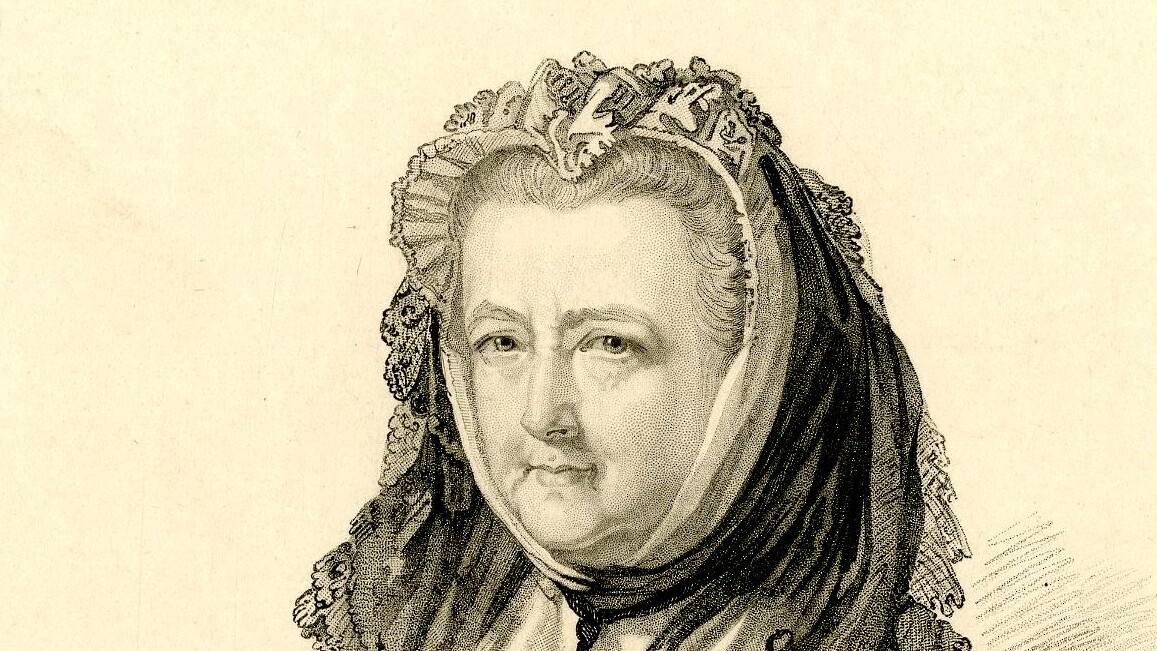Mary Delany (1700-1788) is often remembered for her mastery of paper mosaics, yielding 985 hyper-realistic images of plants. What is less often remembered? The erotic nature of her work and what it tells us about the perception of the female sexual body and same-sex desire in early modern Europe. It’s LGBTQ+ History Month and we are talking about Mary Delany’s sapphic botany!
“Delany’s botanical illustrations are lush, vivid, and sexy. Papaver Somniferum [sic], the Opium poppy (1776), is a striking example of this mammoth group of works (…). It is as if the long view of her landscape drawing has given way to a close-up of the opened, vulval shape as Delany focuses meticulously on floral anatomy. These collages are strikingly unlike other eighteenth-century designs in their stark simplicity, marked by clear outlines and bold colors. The triangular shape of the whole composition, formed by three main stems joining at the bottom of the frame, is reminiscent of the mysterious V-shapes hidden by the folded hands of classic nudes. The slit in the seed-pod on the left suggests an organism in an earlier stage of sexual development, juxtaposed against the fully- opened, blood-red blossom in the center, and the third pod, dried up after blooming. Together, they suggest a sexual/botanical triad. The framing of all three blossom stems by the leaves, treated in a feathery, almost hair-like manner, works as another allusion to human and not just plant anatomy.”
Lisa Lynne Moore in Sister Arts: The Erotics of Lesbian Landscapes (2011)

I first came across Mary Delany in Sue Minter’s book “The apothecaries’ garden: A history of Chelsea Physic Garden” while on a quest to discover plants which marked the history of Chelsea Physic Garden. Mary Delany is famous for having invented a type of paper cutting and collage that she called ‘paper mosaik’. In her book, Sue Minter, former curator of Chelsea Physic Garden, describes her as a ‘most extraordinary and larger-than-life figure […] whose work must be among the most subtle, intricate and lifelike representation of plant ever made in this medium’. Mary Delany would have started making these after visiting Sir Joseph Banks’ (1743-1820) botanical collection after his return from the South Pacific with new plants to introduce to the UK such as Dacrydium cupressinum (red pine) that can still be found in the Garden today. Mary Delany’s connections with Chelsea Physic Garden are multiple. She was friends with botanical artist Georg Dionysius Ehret (1708-1770), himself married to Head Gardener Philip Miller’s (1691-1771) sister in law, and having represented many of Chelsea Physic Garden’s specimens in his work. At least eight out of the 985 collages made by Mary Delany were of specimens supplied by Chelsea Physic Garden, including our star plants Pelargonium triste (night-scented pelargonium) and Punica granatum (pomegranate).
A few weeks after this first encounter, while doing research on the place of women in horticulture and botany, I came across an amazing book: “Sister Arts: The Erotics of Lesbian Landscapes” by Lisa Lynne Moore which added a whole new layer to my understanding of Mary Delany’s work. In her research, Moore is not so much interested in who people had sex with or in how their identity might conform or not to modern sexual identity categories but in lesbianism as “an art-making practice, a form of relationship or community, and sometimes a kind of art object”. In her book, she looks at ways in which women expressed desire for and among women through garden design, letter writing and botanical illustration and dedicates a whole chapter to the fascinating life and practice of Mary Delany.
Mary Delany was married to two men during her lifetime and had at least two long term relationships with other women, Anne Donnellan (1700-1762) and Margaret Harley (1715-1785). While we can’t speculate on the affectional or sexual content of any of these four relationships, Moore insists on the fact that exploring their existence is highly relevant to understanding the pre-history of contemporary lesbian identities. Mary Delany was very clear about the fact that she preferred female friendships to heterosexual marriage as they were ‘disinterested and freely chosen’. In London and Dublin, she was part of a community of women interested in the arts, politics and science which also involved a continuum of affectional modes ranging from ‘sexual intimacy to chaste mutual devotion’.
Mary Delany’s work very much reflected her many interests and constitutes a “remarkable combination of art and science” according to the British Museum which exhibits several of her collages. Each of the plants in the “Flora Delanica”, her collection of paper “mosaicks”, was represented with scientific accuracy and labelled with the plant’s Linnean and common name, its collection number and date of creation. Sir Joseph Banks said about her work that he would “venture to describe botanically any plant from Mrs. Delany’s imitations without the least fear of committing an error.”
In the 1700s flower painting was mostly associated with and aimed at a female audience. Women represented flowers not only for decorative purposes but also for intellectual ones. A perfect example of this is the work of Elizabeth Blackwell (1700-1758) who unified artistic representation and medicinal knowledge through her beautifully illustrated herbal based on Chelsea Physic Garden’s plants.
Elite women in the 1700’s were expected to be able to paint, sketch and draw as it was considered to be a commodity on the marriage market to arouse masculine desire. Instead, Mary Delany’s artistic accomplishment solicited and aroused desire of other women. Through her garden design and botanical illustration work, she created both three-dimensional and two-dimensional spaces for female eroticism.
Mary Delany was highly skilled, having been instructed by William Hogarth (1697-1764) himself. At the time it was unusual for women to study botanical classification and horticulture because exploring plant sexual reproduction was considered ‘unladylike’. Mary Delany completely defied this in her work by highlighting flowers’ reproductive features and suggesting human female anatomy and erotic potential. By doing so, she paired practices that were seen as feminine -flower painting – and masculine – botanical classification – challenging boundaries of gender, artistic hierarchy and intimacy. Mary Delany also exchanged botanical illustration patterns and political ideas with her female friends such as Elizabeth Montagu (1718-1800), famous leading hostess of the bluestocking circle.
Mary Delany’s collages are exceptional, not only as accurate scientific representations but also as a subversive mode of appropriation of gendered practices. Her life and female friendships were full of love and desire but also of political, intellectual, scientific, aesthetic and sensual joys. She celebrated women and female eroticism while documenting plants and their anatomy, crystallizing both in meticulously crafted objects of contemplation.
Want to know more?
Delany, M. (2011). Autobiography and correspondence of mary granville, mrs. Delany (Augusta Hall). Cambridge University Press.
Moore, L. L. (2011). Sister arts: The erotics of lesbian landscapes. University of Minnesota Press.
Minter , S. (1996). The apothecaries’ garden: a history of the chelsea physic garden. The History Press.
References
Beynon, J. C. (2015). Landscapes of lesbian desire. The Eighteenth Century. https://www.proquest.com/scholarly-journals/landscapes-lesbian-desire/docview/1661348778/se-2
British Museum. (n.d.-a). Late bloomer: The exquisite craft of Mary Delany. https://www.britishmuseum.org/blog/late-bloomer-exquisite-craft-mary-delany
British Museum. (n.d.-b). Mary delany. https://www.britishmuseum.org/about-us/british-museum-story/people-behind-collection/mary-delany
Minter , S. (1996). The apothecaries’ garden a history of the chelsea physic garden. The History Press.
Moore, L. L. (2011). Sister arts: The erotics of lesbian landscapes. University of Minnesota Press.
O’Day, R. (2008). Family galleries: Women and art in the seventeenth and eighteenth centuries. Huntington Library Quarterly, 71(2), 323–349. https://doi.org/10.1525/hlq.2008.71.2.323
Vicinus , M. (2012). A usable past. The Women’s Review of Books. https://www.jstor.org/stable/41553312
Top Image: Portrait of Mary Delany as an old woman; half length to left; wearing hood and frilled shawl; vignette; after J Opie; frontispiece to ‘Diary of Madame D’Arblay’ (vol IV: 1842)
Stipple

